#anji culture and art center
Explore tagged Tumblr posts
Text

Cultural Center in China Has Roof Inspired by the Shape of Bamboo Leaves
With a roof inspired by the shape of bamboo leaves, the Anji Culture and Art Center will house six different venues, including a theater, sports center, and art education center. Designed by MAD Architects, the sleek buildings fan out into the surrounding green tea fields that are unique to the area.




#mad architects#design firm#architectural firm#anji culture and art center#china#shanghai#architecture#shape of bamboo leaves#theater#sports center#art education center#future architecture
2 notes
·
View notes
Text
#architecture#amazingarchitecture#design#interiordesign#architect#archilovers#luxury#photooftheday#travel#architecturephotography#china
0 notes
Text
Journal - 26 Extraordinary Architectural Projects Across China
China is no stranger to great architecture. Within the last decade, the country has emerged as the globe’s largest construction market, and as a result, many noteworthy modern projects have been built. The winners’ gallery of last year’s A+Awards, the world’s largest awards program for architecture and building-products, form indisputable proof of China’s rise: An incredible 26 projects across the country were recognized in a plethora of categories. With the 8th Annual A+Awards now open for entries, it is anticipated that many Chinese firms will once again take the spotlight through new and innovative works.
Enter the 8th Annual A+Awards
Showcased below, last year’s Chinese A+Award winners form a celebration of contemporary design ideas throughout the country. From hospitality and sports projects to commercial pop-ups, offices and education spaces, these projects represent an incredible diversity of design approaches and construction methods. Built across a range of scales, they bring an incredible array of contemporary architectural concepts to life. As you consider which of your latest projects to submit for this year’s program, get inspired by China’s best modern architecture:
Boolean Operator by MARC FORNES / THEVERYMANY, China Commercial-Pop-Ups & Temporary, Jury Winner, 2019
For the event of the Jinji Lake Biennial, New York-based studio MARC FORNES / THEVERYMANY installed a large-scale outdoor pavilion on the elevated plaza of the Suzhou Center. Its undulating enclosure interrupts the usual traffic as an unexpected, emergent environment.
Xinglong Bookstore by MUDA-Architects, China Unbuilt Commercial, Popular Choice Winner, 2019
The bookstore’s design takes the idea of “a book falling from the sky” as the starting point of the story, and the architectural form is taken from book. Through this metaphor, the team hoped that people can walk into the building to read themselves, and to complete a journey of self-discovery in a peaceful environment.
Tibet Intangible Cultural Heritage Museum by Shenzhen HuaHui Design, Tibet, China Architecture +Art, Popular Choice Winner, 2019
Tibet is considered to be a holy place close to the sky, with the Potala Palace and Jokhang Temple being pilgrims’ destinations. The team’s basic design concept of “Heavenly Road” is consistent with the most unique natural and cultural genes in Tibet. The concept of “heavenly road” is embodied at three levels.
Play Stack Shenyang by CLOU architects, Shenyang, China Commercial-Shopping Center, Popular Choice Winner, 2019
Designed to be a shopping mall as a playground, ‘Play Stack’ is a kid’s themed mall with piled up boxes containing playful elements. Terraced volumes, connecting staircases and a large roof deck are threaded into a continuous exterior ‘play scape’ path.
Swirling Cloud: Pavilion for BJFU Garden Festival by SUP Atelier, Haidian, Beijing, China Architecture +Ceilings, Popular Choice Winner & Jury Winner, 2019
Located in a grove in the campus of BJFU, the “pavilion of clouds” is a bamboo structure built for 2018 “Bamboo Garden Festival”, and the project was commissioned by the faculty of BJFU. Covering an area of approximately 120 square meters, the pavilion serves as a hub for information during the festival and turns into a flexible place for recreation and gathering when the event is over.
3D Printed Pedestrian Bridge by XWG Archi-Studio, Beijing, Shanghai, China Architecture +Technology, Popular Choice Winner, 2019
Inspired by the ancient Anji Bridge in Zhaoxian, China, this bridge adopts the structure of a single arch to bear the load. The 3D printing concrete system is independently developed by Professor Xu Weiguo’s team. It integrates technologies such as digital architectural design, printing path generation, operation control system, printing tool, concrete material, etc.
123+ Kindergarten by OfficeOffCourse, Shanghai, China Institutional-Kindergartens, Popular Choice Winner, 2019 Architecture +Learning, Popular Choice Winner, 2019
The 123+ kindergarten is located in a newly built shopping center. It adopts the Montessori method of education, which views the child as one who is naturally eager for knowledge and capable of initiating learning in a supportive, thoughtfully prepared learning environment.
Dongsi 5Lmeet by DAGA Architects, Beijing, China Commercial-Coworking Space, Popular Choice Winner & Jury Winner, 2019
The Dongsi 5Lmeet was an abandoned soy sauce factory surrounded by the old gray-tiled buildings. It is not far from the historical Duan Qirui Prime Minister’s Office, and next door is a residential development that’s been there for decades. 5Lmeet was made to be an innovative space in an old community.
Louis Vuitton by Nathan Allan Glass Studios, Beijing, China Architecture +Glass, Jury Winner, 2019
As Louis Vuitton’s flagship store in Beijing China, this high end retail store features a storefront section that was completely renovated with custom kiln formed glass. 32 panels of various sizes, totaling over 1000 square feet of glass, were formed, safety tempered, and installed. The custom design was produced using a special “Freeform Series” production process, which creates deep 3D patterned glass.
Exhibition Center of Longquan National Archaeological Park of China by OfficeOffCourse, Longquan, Lishui, China Architecture +Glass, Popular Choice Winner, 2019 Cultural-Gallery, Popular Choice Winner, 2019
Historically, Longquan celadon is a type of green-glazed Chinese ceramic, known as celadon or green ware, produced from about AD950-AD1550. The national Archaeological Park is built to preserve the Longquan historical kiln conservation sites in Dayao village.
X-House by asap/ adam sokol architecture practice, Beijing, China Architecture +Metal, Jury Winner, 2019
Situated in Beijing’s tallest residential structure, the X-House is a showcase business and residential space for an international entrepreneur. Designed to accommodate business meetings, banquets, guests, and other functions, the space features a 1000-bottle wine cellar, tasting room, and spa bathrooms.
Chishui Danxia World Natural Heritage Visitor Center by West-line Studio, Chishui, Zunyi, China Architecture +Stone, Popular Choice Winner, 2019
This tourist center welcomes visitors to the Danxia World Natural Heritage Site in Chishui region, a popular tourist attraction. The project includes the basic facilities for tourists and is located at the entrance of the scenic area in a V-shaped canyon.
Shenzhen Energy HQ by BIG, Shenzhen, China Commercial-Office – High Rise (16+ Floors), Popular Choice Winner, 2019
Shenzhen Energy HQ is a complex high-rise building comprising office spaces and public functions. The building is based on an efficient and well-designed floor plan, enclosed by a skin specifically optimized and modified to reduce solar heat gain.
“The Shadow Garden” of World Horticulture Expo in Yangzhou by OfficeOffCourse, Yangzhou, China Architecture +Landscape, Popular Choice Winner, 2019
The Shadow Garden is one of the five satellite pavilions located in the first completed phase of 2021 World Horticulture Expo site in Yangzhou. Based on the scheme, this expo reflects the beauty of local landscape and plants as well as its programmatic requirement which is an educational place. The design aims to generate a new relationship between landscape and architecture.
Village Lounge of Shangcun by SUP Atelier, Jixi, China Architecture +Community, Jury Winner, 2019
The village lounge in Shangcun turned the ruined courtyard into a public space, providing leisure, multi-used community space for both local residents and tourists.
VITA-The Fortune Bridge by Arizon Design, Zhengzhou, China Transportation-Transportation Infrastructure, Popular Choice Winner & Jury Winner, 2019
As the main lead into the Shopping Boulevard, the bridge represents the architect’s hope of providing youngsters with emotional support. It is thus referred to as “the Fortune Bridge”.
Bozhou Stadium by Yuan Ye Architects/China Construction Engineering , Bozhou, China Sport & Recreation-Stadium/Arena, Jury Winner, 2019
Bozhou Stadium abstracts the inverted trapezoidal form from Han Dynasty architecture and utilizes it as the basic geometric form of the building. It also uses the square pool along the shape as the “base” to ground the building form and emphasize the purity of the building. Inspired by the local armor of the warriors of the Han Dynasty, the architectural skin simulates the folding of the armor’s surface with a continuous triangular folding surface.
Vanke Emerald Park by Lacime Architects, Chongqing, China Sport & Recreation-Recreation Centers, Jury Winner, 2019
In Vanke Park, the outer frame, column and cornice of the main building are all designed with an oblique section. The horizontal lines of the floor intersect with the inclined planes between the columns, which increases the requirement for construction accuracy. The square main building is surrounded by water on three sides, and the columns of the outer frame fall on the water.
Yunmen Montain all-seasons Resort by ATAH, Qingzhou, Weifang, China Sport & Recreation-Recreation Centers, Popular Choice Winner, 2019
The Yunmen Mountain all-seasons Resort is located at the Qilu Mountain Region. Although the local city of Qingzhou is famous for its history and vernacular architecture, visitors can immediately feel the presence of the vast nature when immersed in the mountains. Hence, the design concept is based on integration into the mountains and nature, rather than cultural expression or history.
Hangzhou Haishu School of Future Sci-Tech City by LYCS Architecture, Hangzhou, China Institutional-Primary & High Schools, Popular Choice Winner, 2019
Traditional school planning in modern Chinese cities usually provides students and children with an adult-scale campus environment at an excessively early stage. Facing these phenomenon, the architects aimed to subversively break these conventions in school planning and offer children with space of their own scale and age in which they could enjoy living and studying.
Hengdian Hotel by gad, China Hospitality-Unbuilt Hospitality, Popular Choice Winner, 2019
The hotel is located in the center of Hengdian City, the “Chinese Hollywood.” The site is surrounded by three sides by mountains which are also forested. The design concept is building the image of the contemporary private residence through the arrangement of courtyards which are based on the space of the local famous private residence called Lu Residence, or “the Folk Forbidden City”.
Dreaming Someone by WAY Studio, Beijing, China Hospitality-Restaurants, Jury Winner, 2019
WAY Studio recently completed the “Aye by Meeting Someone” restaurant in Beijing to explore spatial performance and provide a transient surreal experience to visitors. The spherical entrance, the infamous rabbit hole, crashes into the wall and creates ripples on the exterior façade. Designed with computational scripting, the façade has become a juxtaposition between technology and craftsmanship, linking modernity with tradition.
M50 Art Hotel by MUDA-Architects, China Architecture +Models & Rendering, Popular Choice Winner, 2019
M50 Art Hotel Project is located in Pingle, Sichuan. Pingle Ancient Town is planned to be a music theme town. Therefore, the starting point of this project was around “Music”. In this project, MUDA- Architects strived to explore and activate local culture genes, and to create a landmark building that can inherit the historical context and also is forward-looking.
Boat Rooms on the Fuchun River by The Design Institute Of Landscape & Architecture China Academy Of Art , Hangzhou, China Hospitality-Hotels & Resorts, Popular Choice Winner, 2019
These boat rooms “float” on the west bank of a lake where the resort covers a large area. The concept and shape of the “boat room” take its root in a local social custom from Fuchun.
Dongshang by Imafuku Architects, Beijing, China Hospitality-Bars & Nightclubs, Popular Choice Winner, 2019
Located in Beijing’s central business district, Dongshang is a contemporary Japanese restaurant and bar with a wide selection of sake and Japanese whisky. The vision of the client was to create a Japanese-style venue, while also representing the elements of Chinese culture, as well as featuring natural materials.
One City Development by Aspect Studios, Hubei, China Landscape & Planning-Urban & Masterplans, Popular Choice Winner, 2019
Aspect Studios set out to create a destination that provides a unique response to the public realm of the city and a place that acknowledges the importance of socially orientated space for people. To do this the team drew upon contemporary Wuhan lifestyle and the traditional local mythology of the ‘Phoenix’. The design is structured with a series of diverse spaces, nodes and experiences connected and unified by a fluid gesture and movement.
To be in the running for an iconic A+Awards trophy, publication in “The World’s Best Architecture” book by Phaidon, and a wealth of global publicity on Architizer, make sure your firm enters the 8th Annual A+Awards before the Final Entry Deadline on March 27th, 2020.
Enter the 8th Annual A+Awards
The post 26 Extraordinary Architectural Projects Across China appeared first on Journal.
from Journal https://architizer.com/blog/inspiration/collections/a-architecture-china/ Originally published on ARCHITIZER RSS Feed: https://architizer.com/blog
#Journal#architect#architecture#architects#architectural#design#designer#designers#building#buildings
0 notes
Text
100 Years of Mastery: Golden Kamuy and Judo
Golden Kamuy digs deep into the history and culture of 1900s Japan, showing us life in snowy Hokkaido both in its growing cities and the Ainu's wilderness homes. We've learned all about Ainu food, survival techniques, and even the series' tense political climate--and while we're all wrapped up in the conspiracies and jagged alliances, it's easy to forget that Golden Kamuy is also a violent, rough-and-tumble action-adventure.
In fact, one thing that's surprised me from the get-go (but shouldn't have, really) is how much detail and thought is put into Golden Kamuy's martial arts, and how they and the series' action are informed by the state of martial arts in 1900s Japan. This is covered on multiple fronts with a variety of characters, but let's start with one of the best--Ushiyama the Undefeated and his judo!
Judo, meaning "the Gentle Way," was invented in 1882 by Jigoro Kano, a Tenjin Shin'yo-ryu jujutsu practitioner who was blessed with a great mind and technique but cursed with a small body. Seeking a way to defeat larger, stronger opponents, he collected throwing and submission techniques from multiple jujutsu schools that he later codified into the Go Kyo no Waza, or Five Sets of Techniques. These throws, chokes, armbars, and leg locks became the curriculum of a new fighting system--instead of being a list of physical techniques (jutsu), judo was intended to be an all-encompassing philosophy or way (do), separating it from its origins in jujutsu.
Judo places a heavy emphasis on randori, free practice that focuses on practical application of techniques. It's one thing to practice forms and imagine throwing a human body, and it's another to internalize judo's philosophy of "maximum efficiency, minimum effort." The idea of leverage and technique over strength meant that a judo practitioner would conserve energy and use the smartest possible technique at the right time, instead of muscling through techniques to force a submission or throw. This also means that like in jujutsu (and later aikido), a judo practitioner has to know how to fall, and how to safely receive techniques so their partner can practice with them.
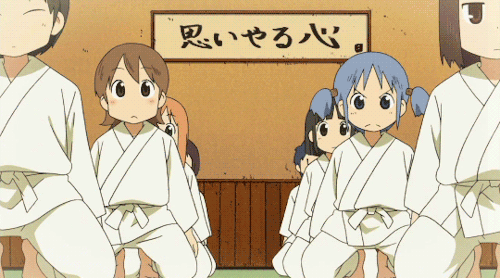
Not like this.
In the time Golden Kamuy takes place, judo is a refreshing new style, almost a fad, that combines the tradition and discipline of martial arts with the excitement and camaraderie of sports. With the Meiji Era's sword ban leading to the development of kendo, it was jujutsu's turn to evolve into a modern style, and competitive judo spread throughout Japan and further, with Kano visiting the United States and Europe. By 1900, changes were made to the competitive judo ruleset prohibiting certain joint locks to create a safer sport, and in 1911 it was inducted into Japan's educational system.
Today, judo is one of the world's most notable, popular martial sports, with schools across the globe. Judo has been an Olympic event since 1964, where it saw a resurgence in worldwide popularity--there was an even an episode of Happy Days where Arnold, played by Pat Morita, taught the kids judo. Martial arts themselves have come full-circle, with jujutsu going through yet another evolution to become Brazilian jiu-jitsu, leading to the modern definition of mixed martial arts. (For real, when you're done reading this go watch Fighting in the Age of Loneliness.)
In the 1964 Tokyo Olympics, Japan took Gold in the Light, Middle, and Heavyweight divisions, but the Netherlands' Anton Geesink took the Open Division Gold
Golden Kamuy mainly uses judo through Ushiyama the Undefeated, an escaped Abashiri convict who's been training for ten years without a single loss. The man already sounds like a monster on that alone, but then you can add the whole seducing-his-master's-wife-and-killing-his-master thing for flavor. Hell, when Shiraishi accidentally runs into him in episode 7, Ushiyama does (kind of an) okuri-ashi-harai on a horse:
And a real one for comparison--watch Hedvig Karakas in blue:
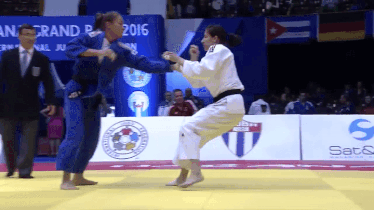
Episode 11 features Sugimoto's group running into Ushiyama again, and Sugimoto takes note of Ushiyama's ears--these are called cauliflower ears, and are a condition caused by blood clots (or other fluid) collecting in the ears' cartilage from blunt trauma. This is most common in combat sports (like judo!) or in contact sports where the ears are unprotected, like rugby.
Here's UFC legend Randy Couture's cauliflower ear, which got made fun of in The Expendables:
Moments after this, Ushiyama shakes Sugimoto's hand, and the two of them immediately get into a standing grapple, or kumi kate. Ideally, you're holding your opponent's sleeve with one hand and their lapel with the other. From here, you start trying to apply kuzushi, or unbalancing techniques, to get into a favorable position to perform a throw. Sugimoto notices that Ushiyama's center of gravity is incredibly low (he feels like it's "below the ground"), so trying to use a throw on Ushiyama would be super difficult and dangerous.
After a filling dinner and a lot of Sapporo beer, everything goes insane and Sugimoto actually has to fight Ushiyama the Undefeated back at the hotel. It's just as ludicrous and insurmountable a task as it sounds, but let's go through it technique-by-technique and watch Sugimoto totally almost die.
First things first: Ushiyama and Sugimoto lock up again, and Ushiyama just slams Sugimoto through a wall.
Sugimoto steps in and goes for what's probably judo's most recognizable technique, the shoulder throw called seoi nage.
And a real seoi nage for comparison:
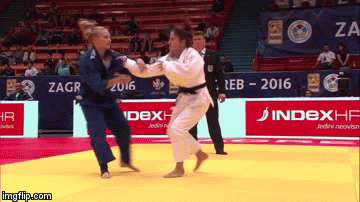
But Ushiyama, being the UNDEFEATED FREAK THAT HE IS, sticks his hand out in the middle of the throw to readjust his balance, and puts his feet up against (and through) the wall to prevent the throw.
And then... yeah, I can't really call this a judo technique as much as it's just the first half of a straight-up Power Bomb (but for the sake of this article, we'll say Ushiyama's doing a modified ushiro goshi, or back drop). Bye, Sugimoto.
To compare, here's a real ushiro goshi:
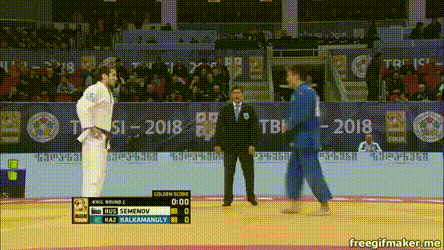
Sugimoto bravely tries to apply a juji gatame armbar on the still-not-fallen Ushiyama, but gets wrenched off the ground and slammed into the ceiling like he weighs nothing. Sugimoto then falls through a trapdoor and that brings this awesome fight to an end.
We don't see much of Ushiyama's judo until the second-season OP, where he does what looks like an uchimata (or a harai goshi?) on a freaking bear:

And then a real uchimata now:
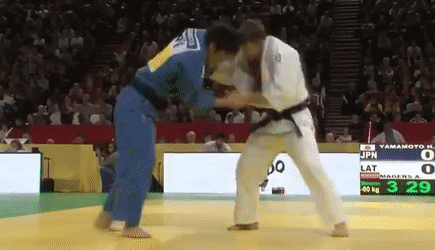
And while Ushiyama hasn't yet had as intricate a fight as the one in episode 11, in episode 21 we got to see an accurate depiction of the technique hadaka jime (aka a rear naked choke) by blind marksman Toni Anji. Notice how he's grabbing hold of his shirt to lock the choke, like how a jujutsu or judo practitioner would grab their gi.
While fighting Toni Anji, Sugimoto goes for another seoi nage, this time tucking his chin to try and drop Anji on his head. It's a very short sequence, but it's safe to say that Sugimoto's regular go-to technique is the seoi nage.
With season 2 of Golden Kamuy over, we're going to have to wait to see if there will be more judo on display. In the meantime, I'll be doing another article soon, this time talking about the history of karate and kenpo as used by the Japanese military, how it's portrayed in Golden Kamuy, and the history of kenjutsu and kendo, specifically Hijikata Toshizou's "Shinsengumi kenjutsu," reportedly derived from Kondo Isami's Tennen Rishin-ryu.
What have you found interesting in Golden Kamuy's martial arts? Have you ever trained in judo or jujutsu? You think you could take Ushiyama? Sound off in the comments and let us know!
-----
Nate Ming is the Features Editor for Crunchyroll News and creator of the long-running Fanart Friday column. You can follow him on Twitter at @NateMing. His martial arts webcomic, Shaw City Strikers, launches January 15, 2019.
0 notes
Text
Travellers’ Guide to Shanghai
Day 221 of 2017
Hello tumblr fam c:
2 weeks ago I started thinking about my 2018 vacation. Originally I concluded that I would be going to Shanghai, Beijing, and another city in between... but plans have changed. My family needs to hit up Hong Kong briefly to run some errands, so we decided to go to explore all of Taiwan and Hong Kong!!
Before I made that decision though, I already researched and compiled a list of all the things people suggested to do in Shanghai. Instead of putting that to waste, I figured I should share it with anyone who can make use out of it!
Outskirts of Shanghai
Zhujiajiao 朱家角
A 1700 years old ancient water town with stone arch bridges and historical buildings.
1 hr transport from Shanghai
Try onion pancakes and pig trotters
Anji Bamboo Forest
Where the film “Crouching Tiger, Hidden Dragon” was filmed.
Chongming Island nature reserve
Third largest island in China
Main attractions:
Chongming Academy — one of the only ancient Confucian academies in Shanghai
Dongping National Forest Park — largest man-made forest in Eastern China with lots to do
Dong Tan Migratory Bird Protection Area — clouds of birds and great seafood
Jin'ao Mountain — a Buddhist site with East-China-garden-style landscaping
Districts
Xintiandi 新天地
Affluent district that was ruled by the French between 1849 and 1946.
Xujiahui
Commercial area
Shopping
East Nanjing Walking Street 南京步行街
Shopping / sightseeing
South Beauty (俏江南) at Super Brand Mall
International brands, luxury brands, as well as some local brands
Try sliced pork with homemade sauce
Not special prices
People’s Square Station Underground Mall
Dimei Mall and Hong Kong Underground Street are connected
Reasonable prices, but variety is limited
Qipu Road 七浦路
Locals’ shopping area, like a flea market
Small shops selling shoes, clothes, bags, luggage, souvenirs, jewelry, toys, etc.
Underground Market at “Shanghai Science & Technology Museum” Metro Station
Tourist trap filled with fakes
Dong Tai Road
Antique stores; all types of junk/treasure (e.g. baskets, ceramics, lanterns)
Taikang Road (Luwan District, Lane 210)
Tiny streets selling crafts and art
Hui Hui Road
Wide, bustling streets with a seemingly endless array of shopping malls
Skyline
Oriental Pearl Tower 东方明珠塔
Flagship Apple Store @ IFC Mall
Shanghai World Financial Center (SWFC) 上海环球金融中心
Currently the tallest structure in China and the second-tallest building in the world. You can pay to access the observation decks and get a paranomic view of Shanghai.
Jin Mao Tower 金茂大厦
88-storey skyscraper. The tower has an observation deck as well and the entrance fee is 100RMB.
Shanghai Tower 上海中心大厦
Under construction. It will surpass SWFC as the tallest structure in China upon its completion.
Riverside Promenade 滨江大道
The Bund 外滩
This is a waterfront area in Shanghai which gives you a paranomic view of Shanghai’s beautiful skyline.
Restaurants
Godiva Café @ IFC Mall
Mr. Choi Patisserie
Hai Di Lao 海底捞火锅 at Shanghai No. 1 Department Store 第一百货商店
Best hotpot (stated by OP)
Jia Jia Tang Bao 佳家汤包
Best dumplings (stated by OP)
Xiao Yang Sheng Jian 小杨生煎
Pan-fried dumplings
Quan Ju De (全聚德) at Purple Mountain Hotel (紫金山大酒店)
Best Peking Roast Duck in China (stated by OP)
Tip: Don’t go to any of the restaurants with large picture menus just off the Nanjing Road. The prices might not be too bad but the food is crappy.
French Concession
Fuxing Park 复兴公园
Sinan Road 思南路
Famous for its century-old plane trees
Shaoxing Road 绍兴路
450m street with cafes, art galleries, book/clothing stores.
Best known as Publishing Street because it houses some of the city’s most famous publishing houses like Shanghai People’s Publishing House and Shanghai Literature and Art Publishing House.
Number 96 — a café known to be Shanghai’s best-preserved example of the shikumen (literally, stone gate) housing style, so named due to the stone door frame.
Tianzifang 田子坊
A lively area that has managed to retain the old world charm of Shanghai with its shikumen buildings and other original architectural structures.
Really crowded but has a unique vibe
Get 豆腐花 and pan-fried squids with chilli sauce
Huaihai and Hengshan roads
Old City of Shanghai
Yuyuan Garden 豫园
Ming Dynasty style buildings that almost seemed to be newly built.
Connected to City God Temple which is both a large temple complex and commerce district specializing in traditional arts and crafts.
West Nanjing Road
Jing An Temple 静安寺
It was first built in 247 AD beside the Suzhou Creek, and subsequently relocated to its current site in 1216. It’s majestic, but the entrance tickets were extremely pricey at 100RMB.
Attractions
Shanghai Science & Technology Museum
Hands-on interactive Science Museum which provides a fun educational experience. It has five main interactive exhibits, audio-visual rides and four interactive theatres. There is even a good food-court where you can have your lunch.
Entry Fees: $8.55 (¥60) adults; $6.45 (¥45) high-school students; $2.85 (¥20) children
Timings: Tuesday to Sunday 9am-5:15pm (last ticket sold at 4:40pm)
Century Park
Shanghai Museum
Located in the Huangpu district of Shanghai
Houses a collection of over 120,000 pieces, including bronze, calligraphy, furniture, ceramics, jades, seals, ancient coins, paintings, sculptures, foreign art and minority art.
The admission is free, only special exhibitions have an admission fee of 20 Yuan.
Jade Buddha Temple
Located in the western part of Shanghai.
Founded in 1882
Features a reclining Buddha 1.95 meters tall and weighing 3 tonnes
Madame Tussauds
Wax museum in Shanghai's Huangpu district
World famous for its life-like wax figures.
Tourists are allowed to make their own hand models by themselves and take them home as souvenirs.
Shanghai Circus World
Located in Zhabei District
1,638-seat circus theater with a revolving stage, computer-controlled lighting, and state-of-the-art acoustics.
Includes a gigantic animal house with rooms for elephants, tigers, lions, chimps, horses, and pandas.
Shanghai Equestrian Course
Professional guides who teach and escort through horse rides.
You will be provided with a retired yet well-behaved and trust-worthy horse. It's been 15 years since its establishment.
Psychedelic Tunnel
This tunnel runs from the Oriental Pearl Tower of Pudong to the Bund of Puxi. $4.74
Shanghai History Museum
Shanghai's history and culture laying an emphasis on the colonial period.
Life-sized models fill the museum.
Entry Fees: ¥35
Shanghai Ocean Aquarium
Largest aquarium of Asia, exhibiting 28 different sections, and housing more than 10,000 aquatic animals including sharks, lion-fish, jelly-fish, turtles, sea otters, Yangzi sturgeon etc.
Highlight: glass tunnel with a clear vision of Sand Tiger shark, Port Jackson shark, Chinese water dragon, giant Gourami etc.
Acrobats
Shanghai Centre Theatre, 1376 Nanjing Road; tickets from Y100-Y200; www.shanghaiacrobats.com
Suzhou
Lion Grove Garden 狮子林园
Allegedly the last remaining rock garden in China.
A Zen Buddhist monk, Wen Tianru, built the Lion Grove Garden in 1342
Humble Administrator Garden 拙政园
The finest garden in Southern China.
The garden is so named because the original owner, Wang Xiancheng was a public servant who had gone through a difficult political career. Hence, he wanted to build a beautiful garden where he could enjoy his twilight years.
Tongli Water Town 同里镇
A rustic charm with its stone bridges, well preserved ancient architecture, private gardens, temples and centuries-old houses.
The town has forty-nine stone bridges, but the most famous are the three bridges named Taiping (peace), Jili (luck) and Changqing (celebration). They are supposed to bring good luck if you walk over all three in sequence.
Pingjiang Road 平江路
A stretch of street along the riverbank that houses a tidy sprawl of modern cafés, traditional Chinese tea houses, souvenir shops, street food vendors and restaurants.
Hangzhou
West Lake (西湖) - bike ride
An iconic freshwater lake in Hangzhou. It is the most popular tourist attraction in Hangzhou.
Liulang Wenying Park
Leifeng Pagoda - The structure was constructed in AD 975, and rebuilt again in 2002 after it collapsed in 1924.
Jingci temple - originally built in AD 954. The temple has been destroyed and rebuilt several times throughout history.
Huagang Park
Three Pools Mirroring the Moon - buy boat tickets - This is an artificial island situated in the south-western part of West Lake. The “three pools” refer to the three pagodas near the island, which have hollows in which lamps can be placed, creating the illusion of moon reflections on the lake.
Yue Fei Temple - boat ride - This is a temple built in honour of Yue Fei, a legendary general of the Southern Song dynasty.
Su Causeway - This bridge is three kilometres long and connects the North and South shores of West Lake. The poet-official Su Dongpo built it during the Northern Song Dynasty.
Autumn Moon over the Calm Lake
Lou Wai Lou
Impressions West Lake show
Must-watch - intimate storytelling, the clever use of West Lake to create spectacular theatrical effects, the beautiful Chinese costumes, and of course, the well-choreographed performances.
Hubin Road
Upscale district of luxury brand shops, restaurants, and shopping malls.
Disclaimer: I’ve never been to Shanghai, so all this information comes from Google searches. These are all recommendations and information from others.
I didn’t keep track of all the sites I went on but here are the ones I could find in my history:
- http://www.eatandtravelwithus.com/2015/08/shanghai-travel-guide/ - http://www.visionsoftravel.org/shanghai-trip-5-days-travel-itinerary/ - http://leaveyourdailyhell.com/2015/11/06/three-days-in-shanghai/ - http://www.mygola.com/7-day-itinerary-for-shanghai/q25190
Thanks for stopping by, see you tomorrow!! &Tell me about your day ♥
0 notes